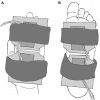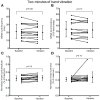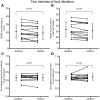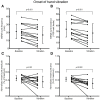Cutaneous Mechanoreceptor Feedback from the Hand and Foot Can Modulate Muscle Sympathetic Nerve Activity
- PMID: 28008306
- PMCID: PMC5143677
- DOI: 10.3389/fnins.2016.00568
Cutaneous Mechanoreceptor Feedback from the Hand and Foot Can Modulate Muscle Sympathetic Nerve Activity
Abstract
Stimulation of high threshold mechanical nociceptors on the skin can modulate efferent sympathetic outflow. Whether low threshold mechanoreceptors from glabrous skin are similarly capable of modulating autonomic outflow is unclear. Therefore, the purpose of this study was to examine the effects of cutaneous afferent feedback from the hand palm and foot sole on efferent muscle sympathetic nerve activity (MSNA). Fifteen healthy young participants (9 male; 25 ± 3 years [range: 22-29]) underwent microneurographic recording of multi-unit MSNA from the right fibular nerve during 2 min of baseline and 2 min of mechanical vibration (150 Hz, 220 μm peak-to-peak) applied to the left hand or foot. Each participant completed three trials of both hand and foot stimulation, each separated by 5 min. MSNA burst frequency decreased similarly during the 2 min of both hand (20.8 ± 8.9 vs. 19.3 ± 8.6 bursts/minute [Δ -8%], p = 0.035) and foot (21.0 ± 8.3 vs. 19.5 ± 8.3 bursts/minute [Δ -8%], p = 0.048) vibration but did not alter normalized mean burst amplitude or area (All p > 0.05). Larger reductions in burst frequency were observed during the first 10 s (onset) of both hand (20.8 ± 8.9 vs. 17.0 ± 10.4 [Δ -25%], p < 0.001) and foot (21.0 ± 8.3 vs. 18.3 ± 9.4 [Δ -16%], p = 0.035) vibration, in parallel with decreases in normalized mean burst amplitude (hand: 0.45 ± 0.06 vs. 0.36 ± 0.14% [Δ -19%], p = 0.03; foot: 0.47 ± 0.07 vs. 0.34 ± 0.19% [Δ -27%], p = 0.02) and normalized mean burst area (hand: 0.42 ± 0.05 vs. 0.32 ± 0.12% [Δ -25%], p = 0.003; foot: 0.47 ± 0.05 vs. 0.34 ± 0.16% [Δ -28%], p = 0.01). These results demonstrate that tactile feedback from the hands and feet can influence efferent sympathetic outflow to skeletal muscle.
Keywords: afferent feedback; autonomic nervous system; cutaneous; microneurography; muscle sympathetic neural activity; vibration.
Figures






Similar articles
-
Cutaneous afferent innervation of the human foot sole: what can we learn from single-unit recordings?J Neurophysiol. 2018 Sep 1;120(3):1233-1246. doi: 10.1152/jn.00848.2017. Epub 2018 Jun 6. J Neurophysiol. 2018. PMID: 29873612 Free PMC article. Review.
-
The firing characteristics of foot sole cutaneous mechanoreceptor afferents in response to vibration stimuli.J Neurophysiol. 2017 Oct 1;118(4):1931-1942. doi: 10.1152/jn.00647.2016. Epub 2017 Jul 5. J Neurophysiol. 2017. PMID: 28679842 Free PMC article.
-
Arterial baroreflex regulation of muscle sympathetic nerve activity at rest and during stress.J Physiol. 2019 Sep;597(18):4729-4741. doi: 10.1113/JP278376. Epub 2019 Aug 25. J Physiol. 2019. PMID: 31368530
-
Divergent muscle sympathetic responses to dynamic leg exercise in heart failure and age-matched healthy subjects.J Physiol. 2015 Feb 1;593(3):715-22. doi: 10.1113/jphysiol.2014.281873. Epub 2014 Dec 15. J Physiol. 2015. PMID: 25398528 Free PMC article.
-
Microneurography as a tool in clinical neurophysiology to investigate peripheral neural traffic in humans.Clin Neurophysiol. 2006 Nov;117(11):2357-84. doi: 10.1016/j.clinph.2006.06.002. Epub 2006 Aug 10. Clin Neurophysiol. 2006. PMID: 16904937 Review.
Cited by
-
Cutaneous afferent innervation of the human foot sole: what can we learn from single-unit recordings?J Neurophysiol. 2018 Sep 1;120(3):1233-1246. doi: 10.1152/jn.00848.2017. Epub 2018 Jun 6. J Neurophysiol. 2018. PMID: 29873612 Free PMC article. Review.
-
Cardiovascular responses during isometric exercise following lengthening and shortening contractions.J Appl Physiol (1985). 2019 Feb 1;126(2):278-285. doi: 10.1152/japplphysiol.00601.2018. Epub 2018 Nov 1. J Appl Physiol (1985). 2019. PMID: 30382808 Free PMC article.
-
Cutaneous warmth, but not touch, increases muscle sympathetic nerve activity during a muscle fatigue hand-grip task.Exp Brain Res. 2020 Apr;238(4):1035-1042. doi: 10.1007/s00221-020-05779-x. Epub 2020 Mar 20. Exp Brain Res. 2020. PMID: 32198543 Free PMC article.
-
Effect of Different Local Vibration Frequencies on the Multiscale Regularity of Plantar Skin Blood Flow.Entropy (Basel). 2020 Nov 13;22(11):1288. doi: 10.3390/e22111288. Entropy (Basel). 2020. PMID: 33287056 Free PMC article.
-
Effects of plantar-sensory treatments on postural control in chronic ankle instability: A systematic review and meta-analysis.PLoS One. 2023 Jun 27;18(6):e0287689. doi: 10.1371/journal.pone.0287689. eCollection 2023. PLoS One. 2023. PMID: 37368906 Free PMC article.
References
LinkOut - more resources
Full Text Sources
Other Literature Sources

